Hi all,
Over in the Electric Projects subforum, I posted my plans for a battery powered yard wagon (Thread Here) a few days ago. I have some questions related to the drive-train that are not necessarily electric-specific, so I am posting those in this subforum to perhaps get more input.
As described in my design thread, my plan is to build the wagon with differential steering (like a skid steer or tank). In this arrangement, the two rightside wheels are driven together and the two leftside wheels are driven together. An 800w electric motor will drive each side of the wagon independently. See below photos.
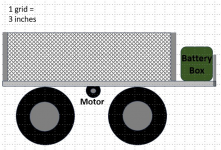
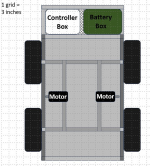
I really don't have any experience with drivetrains, sprockets, chains, etc. so be prepared for some potentially dumb questions ahead.
Based on some youtube videos, I was initially hoping to install a second sprocket on the motor shaft (it comes with one 11T 420 by default) and have a chain running from each of the two motor shaft sprockets to the front and rear wheel, as seen below.
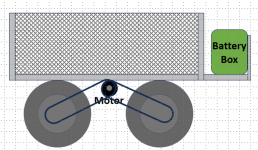
Unfortunately, after having received the motor, I have determined that the shaft is not long enough to accommodate 2 sprockets. So the single sprocket will have to do for now.
The fallback option is to now connect the motor sprocket to the right (or left) rear axle and then from the rear axle to the front axle. That arrangement will look something like this…
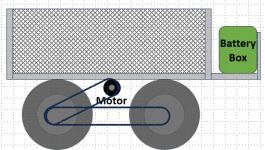
I assume it is advantageous to move the motor as close as possible to the rear axle in this case, which appears as:
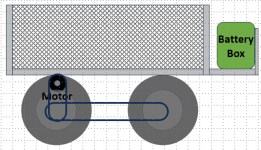
As of right now, this appears to be the direction I am heading. The only thing that concerns me is how low the chain is to the ground between the two wheels. Clearance may pose a problem. Does anyone have any suggestions to improve upon the sprocket placement and chain path?
Another question related to sprockets. I have read it is not preferrable to have a very small sprocket directly linked to a large sprocket. In my case, the motor shaft sprocket is 11 teeth and the wheel sprocket needs to be 60 teeth (to limit maximum speed). Would this jump be acceptable or will there need to be a stage in between?
Also, I don’t know much about chain tensioning. If the sprocket distances are short (from the motor to the rear wheel), there doesn’t have to be any tensioning device so long as the motor mount is adjustable? I assume there would be tensioning on the chain between a front/rear wheel, but unsure what that would look like at the moment.
Finally, the motor comes installed with a #420 chain sprocket. Is 420 chain sufficient for this application? I am not familiar with the various chain sizes and was just going to go with what was on there from the factory.
Appreciate any input folks have on this topic. Thanks!
Over in the Electric Projects subforum, I posted my plans for a battery powered yard wagon (Thread Here) a few days ago. I have some questions related to the drive-train that are not necessarily electric-specific, so I am posting those in this subforum to perhaps get more input.
As described in my design thread, my plan is to build the wagon with differential steering (like a skid steer or tank). In this arrangement, the two rightside wheels are driven together and the two leftside wheels are driven together. An 800w electric motor will drive each side of the wagon independently. See below photos.


I really don't have any experience with drivetrains, sprockets, chains, etc. so be prepared for some potentially dumb questions ahead.
Based on some youtube videos, I was initially hoping to install a second sprocket on the motor shaft (it comes with one 11T 420 by default) and have a chain running from each of the two motor shaft sprockets to the front and rear wheel, as seen below.

Unfortunately, after having received the motor, I have determined that the shaft is not long enough to accommodate 2 sprockets. So the single sprocket will have to do for now.
The fallback option is to now connect the motor sprocket to the right (or left) rear axle and then from the rear axle to the front axle. That arrangement will look something like this…

I assume it is advantageous to move the motor as close as possible to the rear axle in this case, which appears as:

As of right now, this appears to be the direction I am heading. The only thing that concerns me is how low the chain is to the ground between the two wheels. Clearance may pose a problem. Does anyone have any suggestions to improve upon the sprocket placement and chain path?
Another question related to sprockets. I have read it is not preferrable to have a very small sprocket directly linked to a large sprocket. In my case, the motor shaft sprocket is 11 teeth and the wheel sprocket needs to be 60 teeth (to limit maximum speed). Would this jump be acceptable or will there need to be a stage in between?
Also, I don’t know much about chain tensioning. If the sprocket distances are short (from the motor to the rear wheel), there doesn’t have to be any tensioning device so long as the motor mount is adjustable? I assume there would be tensioning on the chain between a front/rear wheel, but unsure what that would look like at the moment.
Finally, the motor comes installed with a #420 chain sprocket. Is 420 chain sufficient for this application? I am not familiar with the various chain sizes and was just going to go with what was on there from the factory.
Appreciate any input folks have on this topic. Thanks!
